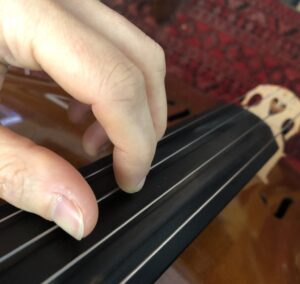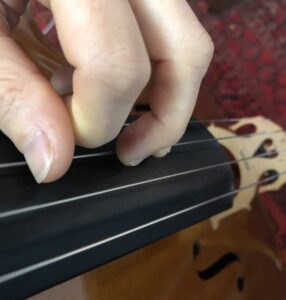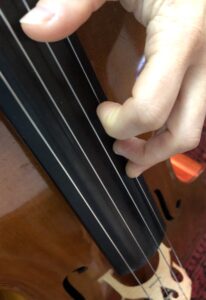Every year I give a recital, and this year’s concert is next week. The other day a friend asked, ‘What if it was tomorrow? Would that be ok?’ -well, yes, but that doesn’t mean I’m done practising. In fact I tend to wake up early and take my time in the wee hours before the sun is up to think and play carefully. There is always something to mine into, and with any physical skill, it needs to be maintained. If you can do a high jump today does not guarantee that you can still do it several days later. This doesn’t mean it is impossible – quite the opposite! Through strategic deconstruction, analytical thinking, listening, reflection, and repetition I not only believe, but know I can do it. I actually can play this, and I am looking forward to next Thursday’s event.
Let me take you through what I did this morning…
Today my indulgent hour at 6am (first hour of practise) was focused on hand shapes and their relationships in this passage fromSchnittke’s Musica Nostalgica. There’s this one passage (the first two notes are not pictured, they are an A and B leading up to the C, which is pictured)
The various bits are highlighted so I can align them with the images of my hand.
As you play this there are things to listen for and check. Here’s my thinking (and yes, it is very cello-specific, but I’ll make it so anyone can follow the principles)
Overall this passage should sound just like a lovely tune. Technically there are quite a few fundamentals that need to be in place so you can actually achieve that.
The first bit begins in the classic thumb position place
(all of the 0 markings are actually played with your thumb, but I don’t have a ‘thumb’ symbol, which looks a bit like a 0 on a stick). In this place the 1 (purple section) makes a perfect 4th with the A (thumb) and this can be checked, as the 0 and 1 are on different strings. Checking involves playing the two notes simultaneously, to hear the interval, even though this is not the way the ‘tune’ is written. Here’s what the hand looks like in the purple section:
 Then for the next note, labelled 0, the hand moves up to what anyone who has studied Hans Jensen’s Fun in Thumb Position will know as ‘violin position’. The thumb ‘anchors’ on the E, which is also a harmonic, so that makes it easy to check and learn as a physical place on the un-fretted fingerboard. The next six notes are all in that position (through the orange-red underline). The important note here is played by 3. I’ll explain why. First here’s a picture of the hand playing the orange-red underline:
Then for the next note, labelled 0, the hand moves up to what anyone who has studied Hans Jensen’s Fun in Thumb Position will know as ‘violin position’. The thumb ‘anchors’ on the E, which is also a harmonic, so that makes it easy to check and learn as a physical place on the un-fretted fingerboard. The next six notes are all in that position (through the orange-red underline). The important note here is played by 3. I’ll explain why. First here’s a picture of the hand playing the orange-red underline:
 OK, in bar 103 (the second bar of music pictured above), there are two 3s and a 2. these are all in teh same geographical place. The first 3 and the following 2 are actually the same pitch, played by a different finger, and the second 3 is simply on a different string (on a higher string) It is a lateral move – like side-stepping, as opposed to going up or down. This means I need to listen to the first 3 and know where it is spatially, then when I go to play the 2, that finger reaches a bit to be in the exact same spot.
OK, in bar 103 (the second bar of music pictured above), there are two 3s and a 2. these are all in teh same geographical place. The first 3 and the following 2 are actually the same pitch, played by a different finger, and the second 3 is simply on a different string (on a higher string) It is a lateral move – like side-stepping, as opposed to going up or down. This means I need to listen to the first 3 and know where it is spatially, then when I go to play the 2, that finger reaches a bit to be in the exact same spot.
Why?
So I can travel the hand in an inchworm fashion in order to reach the next notes. I can reach to the 3 (start of the blue underline) and then another one of these ‘finger replacements’ happens. The 2 is replaced by a 1. -Now to the listener, it should just sound like the same pitch and nobody should notice these finger gymnastics. This is admittedly something that takes a bit of work to get right. Here’s the shape:
 You’ll see that I am travelling up and up the fingerboard (which on cello is actually down to the ground to go ‘higher’ in pitch). There is something really important about this place. So as a player I am pretty concerned with tuning up there, and with the bow so I can make the strings speak clearly as I am in the stratoshpere. But! But I also need to pay attention to the top note and to my hand shape. The top note is a B and I need to have my hand in an octave shape so my thumb is on the lower B even though I do not need to play this note here. I need to get ready by finding this shape, because I will need it later!
You’ll see that I am travelling up and up the fingerboard (which on cello is actually down to the ground to go ‘higher’ in pitch). There is something really important about this place. So as a player I am pretty concerned with tuning up there, and with the bow so I can make the strings speak clearly as I am in the stratoshpere. But! But I also need to pay attention to the top note and to my hand shape. The top note is a B and I need to have my hand in an octave shape so my thumb is on the lower B even though I do not need to play this note here. I need to get ready by finding this shape, because I will need it later!
These next three notes (green underline)
are where I need my thumb on B, and it can seem like a note to find from outer space, but actually I should have prepared for it already and then I will find it is just there when I need it. I’ll admit that the top D and the G# are both notes that simply have to be learned. Mentally I imagine the G# as being just under A, which is another of those ‘anchor’ sort of notes. -and the D? Well that’s just practice and spatial/muscle memory. Here’s the green underline shape. You’ll see my thumb has stayed put on that B (pictured left).
 Whew, nearly there!
Whew, nearly there!
For the last bar pictured, I need to think relationally. So the C# is just under the D (where 3 was) and the A is just above where 1 was, so those fingers have a minimal move.  There is then a shift back for the last three notes (brown underline) and the E is an anchor note. It was the root of what I called ‘violin position’ above. Just this time it’s played with 3 instead of thumb. It is also just below where our thumb was on the B. -You may say, um, Laura, sorry but B is not near E in any alphabet that I know… and you would be right, but because of the layout of the cello, the notes are in a 5th relation across the strings, and that means that opposite B is F, which is just next to E. Hooray!
There is then a shift back for the last three notes (brown underline) and the E is an anchor note. It was the root of what I called ‘violin position’ above. Just this time it’s played with 3 instead of thumb. It is also just below where our thumb was on the B. -You may say, um, Laura, sorry but B is not near E in any alphabet that I know… and you would be right, but because of the layout of the cello, the notes are in a 5th relation across the strings, and that means that opposite B is F, which is just next to E. Hooray!
Here are those last three notes (pictured right):
And here’s what it sounds like (at 6:30am today) 🙂
Now the trick is to be able to do that in the piece, with a camera pointed at me, and no audience (that I can see) next Thursday. Let’s just say I’m going to keep practising!
Hope you can join me at my concert. It is completely free and will be just over an hour long.
7:30pm GMT Thursday 19 November
Here’s the link https://chiplayer.cloud.panopto.eu/Panopto/Pages/Viewer.aspx?id=becef0de-248a-4345-a8c8-ac5d0093a590

